Table of Contents
- Pond water is a complex ecosystem filled with a vast array of microorganisms. These simple, single-celled organisms are the building blocks of life and can be found all around the world. They constitute a diverse group of organisms, including members of the plant kingdom, fungi, bacteria, and protozoa. Although they are invisible to the naked eye, their presence is felt as they play crucial roles in maintaining the ecological balance of pond ecosystems.
- Under the lens of a microscope, the hidden world of pond water comes to life. Thousands of these tiny microorganisms can be observed within just a single drop of water. They dance and dart around, each carrying out their specific functions in this miniature aquatic world.
- Bacteria, the tiniest of all microorganisms, are abundant in pond water. Despite their small size, they play a vital role in the pond ecosystem. Some bacteria are decomposers, breaking down organic matter and recycling nutrients back into the environment. Without these decomposers, the pond would become a stagnant, lifeless place.
- Fungi are also present in pond water. They contribute to the decomposition process as well, breaking down dead plant material and helping to recycle nutrients. Additionally, fungi form symbiotic relationships with many aquatic plants, aiding in their nutrient uptake and overall growth.
- Protozoa are another group of microorganisms that thrive in pond water. These single-celled creatures are diverse in shape and behavior. Some protozoa are herbivores, grazing on algae and other microorganisms, thus controlling their population. Others are predatory, feeding on bacteria and other smaller protozoa. This intricate web of predation helps maintain a balanced pond ecosystem.
- Within pond water, microorganisms often form colonies, which are visible to the naked eye or when using a magnifying glass. These colonies can consist of thousands or even millions of individual microorganisms working together in a cooperative manner. Sometimes, these visible colonies create intriguing patterns and colors on the water’s surface, captivating observers and sparking curiosity about the hidden world beneath.
- The health of a pond is closely tied to the population and activity of microorganisms. As indicators of water quality, the presence of certain microorganisms can reveal important information about the pond’s overall condition. A thriving and diverse microorganism community signifies a well-balanced ecosystem, whereas a sudden decline in certain populations may indicate pollution or other environmental issues.
- Educational institutions, researchers, and nature enthusiasts often explore pond water to study the diversity and behavior of microorganisms. These studies shed light on the fascinating interactions and adaptations that occur within this microscopic world.
- In conclusion, the microscopic realm of pond water is teeming with life, where a single drop contains a multitude of microorganisms. They form an intricate web of interactions, playing critical roles in nutrient cycling, decomposition, and the overall health of the pond ecosystem. By understanding and appreciating the significance of these tiny creatures, we can gain a deeper appreciation for the delicate balance of nature and the importance of preserving these aquatic habitats.
Types of Microorganisms In Pond Water
1. Arthropods
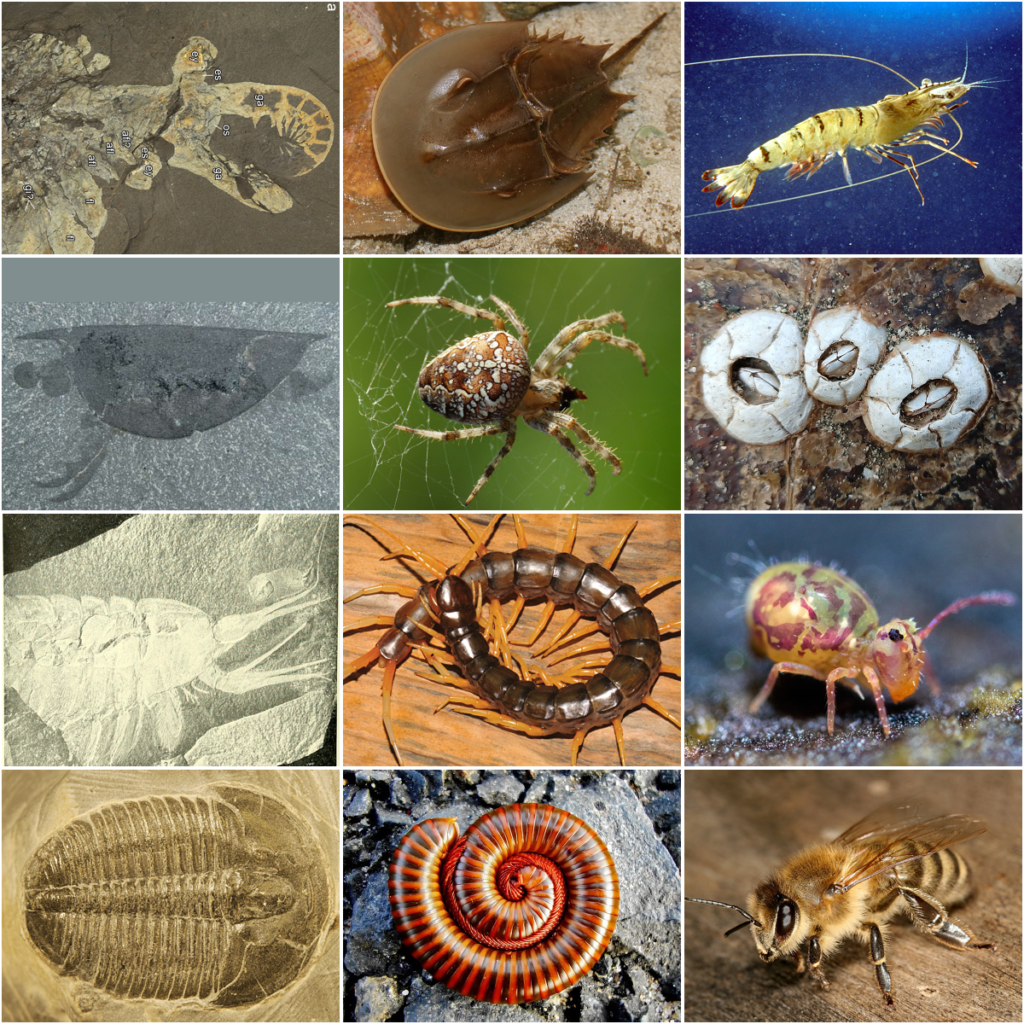
- Arthropods are a diverse group of organisms found in pond water, comprising various microorganisms that are visible to the naked eye. Some of the common arthropods in pond ecosystems include copepods, water fleas, ostracods, water mites, mosquito larvae, water bears (tardigrades), water shrimp, and water lice. The largest specimens among them can reach lengths exceeding 3 millimeters, allowing them to be easily observed without the need for a microscope.
- These arthropods play essential roles within the ecosystem, serving various functions that contribute to the overall balance and health of the pond. They serve as a vital food source for other creatures, such as fish, creating a dynamic food web. Additionally, they contribute to soil aeration, ensuring that oxygen is distributed throughout the pond environment. Some arthropods play a crucial role in controlling the population of other microorganisms, like algae, which can become problematic if left unchecked.
- Interestingly, some arthropods, such as mosquito larvae, are considered part of this group themselves. However, their presence in the pond might indicate a potential issue with stagnant water and poor water quality. Monitoring and adjusting the water quality is essential to maintain a healthy pond ecosystem.
- Arthropods exhibit a wide range of sizes, from tiny water mites barely visible to the naked eye to larger creatures like monarch butterflies, which are also classified as arthropods. Their varied sizes and functions make them important contributors to proper ecosystem functioning.
- In man-made ponds, the presence of certain arthropods is beneficial, while others may indicate potential problems. For example, the appearance of tardigrades is generally a positive sign, as these resilient creatures can thrive in various damp environments, contributing to the pond’s ecological balance. On the other hand, an abundance of mosquito larvae might signal that the pond is not adequately circulating or that its water quality needs improvement.
- Overall, arthropods are a critical component of pond ecosystems, supporting biodiversity and contributing to the balance of the environment. Understanding their roles and monitoring their presence can help ensure the health and sustainability of the pond and its surrounding ecosystem.
2. Bacteria

- Bacteria are incredibly small yet abundant microorganisms present in all aquatic systems, including ponds. Under favorable conditions, such as after rainfall, bacteria can experience rapid multiplication, reaching millions per milliliter within a short period of time.
- In pond water, bacteria can be found on the surfaces of various decaying materials, like leaves, metallic objects, rocks, and wood. Unfortunately, contact with such objects can sometimes lead to serious infections in individuals due to the presence of harmful bacteria.
- There are different types of bacteria in ponds, with two main categories being autotrophic and heterotrophic bacteria. Autotrophic bacteria are often categorized as algae and act as primary producers in the ecosystem. On the other hand, heterotrophic bacteria play a vital role in breaking down organic matter through decomposition. It’s important to note that while heterotrophic bacteria are sometimes referred to as “algae,” they are not closely related to true algae.
- Bacteria constitute a significant portion of living organisms in aquatic systems and demonstrate a wide range of metabolic capabilities compared to other microorganisms. Some common bacteria found in pond water include Nostac and Anabaena, which belong to the cyanobacteria group. Cyanobacteria are responsible for the greenish coloration of pond water.
- Bacteria have earned a reputation as both good and bad microorganisms. Despite the negative connotations, ecosystems and their inhabitants, including humans, heavily rely on bacteria for survival. They are among the tiniest and oldest microorganisms on Earth and can be found virtually everywhere, from a tiny raindrop to the cap of an ink pen.
- Their ability to multiply quickly makes them exceptional at aiding in decomposition and nutrient cycling within ecosystems. Heterotrophic bacteria, in particular, are crucial for breaking down organic matter and recycling nutrients. Additionally, they can help control algae populations by reducing the nutrients available to them.
- Autotrophic bacteria, commonly known as cyanobacteria (although not true algae), have a symbiotic relationship with certain species of algae and fungi. They are responsible for fixing nitrogen, making it available to other organisms. Having some cyanobacteria in a pond is beneficial, but an excessive amount indicates poor water quality and often leads to green, foul-smelling water. Regular monitoring of water quality is essential to maintain a balanced pond ecosystem.
3. Protozoa
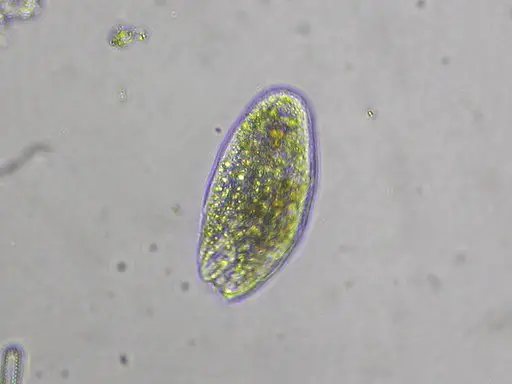
- Protozoa are fascinating microorganisms that display characteristics similar to simple animals. They comprise the largest group of organisms in terms of numbers, diversity, and biomass. Due to this vast diversity, protozoa come in various shapes, sizes, and features.
- Similar to bacteria, protozoa can form clusters or colonies. While some are autotrophic, meaning they can produce their own food, many are heterotrophic and consume a variety of other organisms, including algae and other protists.
- In pond water, protozoa play a crucial role in forming the biofilm that coats sediments and other surfaces. Their ability to move independently allows them to navigate from one location to another without solely relying on water movement. This mobility enables them to actively consume other organisms in the pond. Some of the common protozoa found in pond water include amoebas, paramecium, and various ciliates.
- Protozoa are unicellular, microscopic organisms that resemble animals in their need to consume other organisms for essential nutrients. They play an important role in the pond’s ecosystem by feeding on bacteria and detritus. This, in turn, prevents bacteria from reaching harmful levels and sustains the food web in the pond.
- It’s worth noting that protists, or protozoans, belong to a distinct group with an estimated 50,000 plus species. Some common species found in ponds include Euglena, Paramecium, amoebas, and ciliates. Most protozoa are considered beneficial as they contribute to the functioning of the pond ecosystem and help create biofilms that serve as a food source for various organisms.
- However, around one-third of protozoa species are parasitic and can cause diseases, such as giardia. Despite this, having protozoa in a pond is essential for a healthy ecosystem. Without them, the pond’s ecological balance would be severely affected, limiting the survival of plants and animals within it. Protozoa’s role as primary consumers, regulating bacterial populations, and contributing to the food web makes them indispensable components of pond life.
4. Hydra
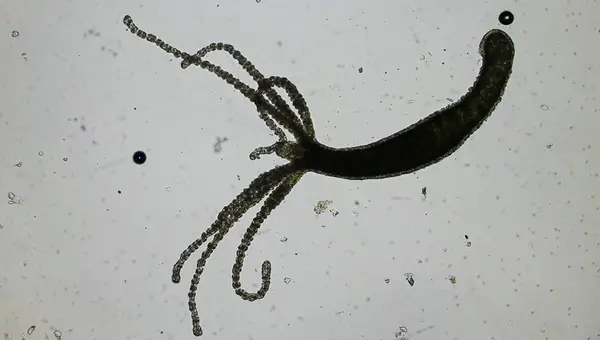
- Hydra, a member of the class Hydrozoa, is primarily found in pond water, unlike most of its marine water-dwelling relatives. These fascinating microorganisms are predatory animals that actively hunt their prey.
- Typically small in size, hydra can grow to be about 30 mm long when fully extended. Due to their tiny size, they are barely visible to the naked eye, often requiring a hand lens to observe them closely.
- There are various types of hydra with colors ranging from green to brown. The green color in some hydra is a result of a mutualistic relationship with green algae. In this symbiotic association, the hydra benefits from the algae’s photosynthetic compounds as a food source, while the algae find protection from predators that might otherwise consume them. This close relationship with algae sometimes leads to confusion, and some students might mistake hydras as belonging to the plant kingdom.
- Hydras are considered animals and are known for their predatory behavior in freshwater environments, particularly in ponds, lakes, and slow-moving water bodies. They prey on a variety of creatures, with a particular preference for insect larvae and small crustaceans. Remarkably, hydras are not known to die of old age; their mortality is usually attributed to injury, disease, starvation, or being eaten by other organisms.
- With their extremely tiny tentacles, hydras attach themselves to rocks, logs, and aquatic vegetation in their habitat. They rely on this fixed position to capture and feed on whatever passes by or shares the same surface as them. Despite their predatory nature, hydras are generally considered neither good nor bad for the pond ecosystem.
- In summary, hydra is a unique and intriguing microorganism belonging to the class Hydrozoa. Found predominantly in pond water, they are predatory animals that rely on their tiny tentacles to catch prey. While they may appear insignificant due to their size, their role in the pond ecosystem is noteworthy, and some species have even developed a mutually beneficial relationship with algae.
5. Algae
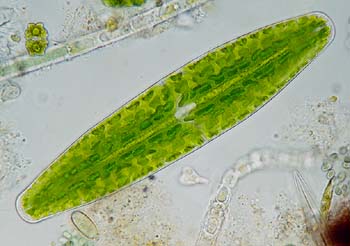
Algae are autotrophic protists commonly found in pond water. They exhibit a wide range of colors, with most microorganisms being green, while some may appear yellowish-brown. The diversity of algae extends to their structure, where they can exist as unicellular or multicellular organisms.
In pond water, several common forms of algae can be found, including spongomonas, euglena, and chlamydomonas. Among these, some algae, like chlamydomonas, are capable of free swimming in search of food, while others, such as spongomonas, reside in gelatinous matrices and employ unique adaptations to gather food without moving.
Algae can be categorized based on their characteristics:
- Planktonic Algae: These algae float on the surface of pond water.
- Filamentous Algae: Also known as pond scum, this type rises to the water’s surface from the bottom.
- Colonial Diatoms: They tend to grow in colonies.
- Resistant Algae: These algae possess special features and characteristics that make them hard to control.
- Toxic Algae: This category includes blue-green bloom forming species of algae, which can be harmful.
Algae are of great significance in pond ecosystems as they form the foundation of the food web. They are consumed by various organisms, such as insects, fish, birds, herps (amphibians and reptiles), and mammals. In addition to their role as a food source, algae play a crucial role in oxygen production and nutrient cycling within the pond.
The number of algae species remains a topic of debate, with estimates ranging from 1 million to 350 million. While some algae, like diatoms, are beneficial and contribute significantly to oxygen production, others like euglena can become problematic. Euglena can cause a bloom, turning the pond water bright red and severely impacting water quality. Controlling euglena populations can be challenging, as they do not respond to known biological or manual control methods.
Monitoring water quality regularly is essential to minimize the risk of algae and other microorganisms becoming problematic in ponds. Understanding the different types of algae and their potential impact helps pond owners maintain a balanced and healthy ecosystem.
6. Phytoplankton
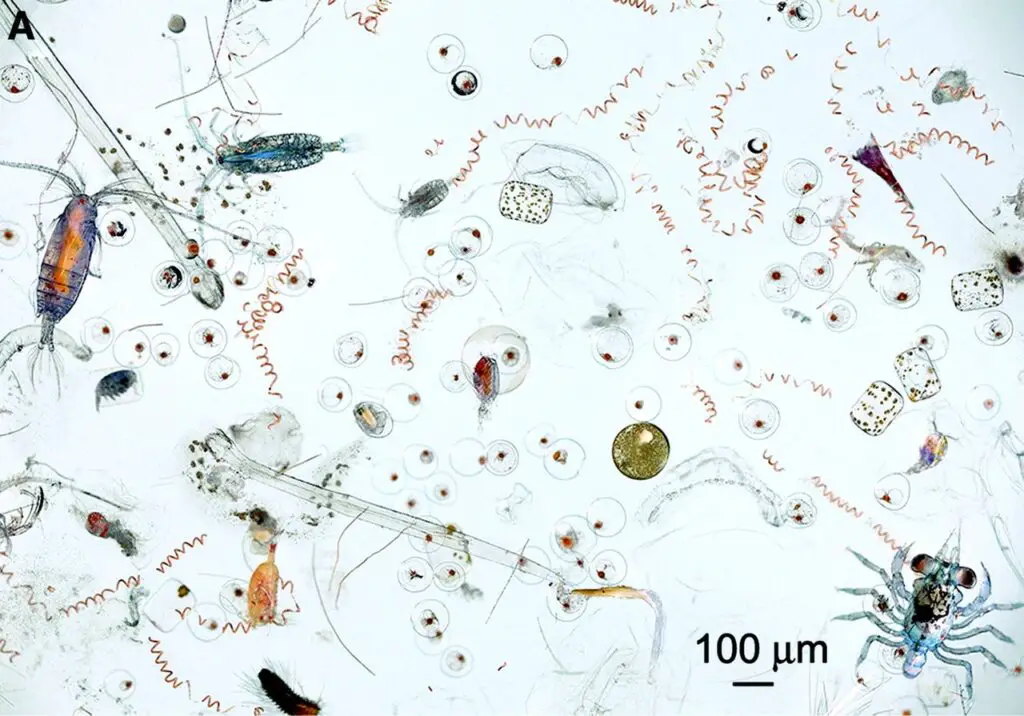
- Phytoplankton are microscopic, floating plants that thrive in still water environments, such as ponds or the deep ocean. Due to their preference for still waters, streams and rivers do not typically harbor significant populations of phytoplankton, as the faster flowing waters wash them away before they can reproduce. These organisms exist as single-celled organisms but often form colonies for survival.
- Phytoplankton play a crucial role in aquatic ecosystems as they serve as a primary food source for zooplankton, aquatic invertebrates, and certain species of fish. Their abundance and health directly impact the entire food chain in aquatic environments.
- While phytoplankton are beneficial as a food source, their rapid growth can lead to potential issues. High numbers of phytoplankton can result in increased algae populations, leading to algal blooms. Algal blooms can negatively impact water quality and disrupt the balance of the ecosystem.
- To control phytoplankton numbers and prevent algal blooms, it is essential to strike a balance. One way to achieve this is by introducing a bit more water flow into the pond using devices such as aerators, pumps, or waterfalls. These additions can help control phytoplankton populations without entirely removing them, preserving their role in the ecosystem.
- Managing phytoplankton levels is crucial for maintaining a healthy and sustainable aquatic environment. By understanding their importance and implementing appropriate measures, pond owners can ensure the well-being of their ponds and the organisms that depend on them.
7. Fungi

- Fungi, despite being relatively large and easily visible, are classified as microorganisms. They can exist as single-celled organisms that start off small or as filaments called hyphae. These hyphae often form a mutualistic relationship with plant roots, aiding the plant in obtaining nutrients from the soil while receiving compounds from the roots in return.
- As heterotrophic organisms, fungi rely on external sources for nutrients. They release enzymes into their surrounding environment that break down various compounds and nutrients into forms that can be used by the fungi itself and other organisms. Through this process, fungi play a significant role in nutrient cycling and decomposition, making them essential components of ecosystems.
- One of the remarkable abilities of fungi is their capacity to break down tough plant structural compounds like lignin, tannins, and cellulose. This makes them key players in the decomposition of aquatic plant matter. By breaking down these compounds, fungi prevent the buildup of nutrients in ponds, which is crucial for maintaining healthy water quality.
- In summary, fungi may appear large and easily noticeable, but they are, in fact, microorganisms. They can exist as single-celled organisms or in the form of hyphae with a mutualistic relationship with plant roots. As heterotrophic organisms, fungi release enzymes to break down compounds and nutrients, contributing to nutrient cycling and decomposition. Their ability to break down tough plant compounds is particularly significant in aquatic environments, where they help maintain healthy water quality by preventing nutrient buildup.
FAQ
What types of microorganisms can be found in pond water?
Microorganisms commonly found in pond water include bacteria, protozoa, algae, fungi, and phytoplankton.
Are all microorganisms in pond water harmful?
No, not all microorganisms in pond water are harmful. Many of them play vital roles in the pond ecosystem, such as nutrient cycling and providing food for other organisms.
What are the main functions of bacteria in pond water?
Bacteria in pond water are essential for breaking down organic matter, aiding in nutrient cycling, and maintaining water quality.
How do protozoa move and feed in pond water?
Protozoa have the ability to move independently, allowing them to search for and consume other organisms, including algae and other protists.
What is the significance of algae in pond water?
Algae are autotrophic protists that form the base of the pond’s food web. They provide food for various organisms, but their overgrowth can lead to algal blooms, impacting water quality.
How do phytoplankton contribute to the pond ecosystem?
Phytoplankton are floating, microscopic plants that serve as a primary food source for zooplankton, aquatic invertebrates, and some fish species, supporting the entire food chain.
Can fungi be considered microorganisms in pond water?
Yes, fungi are classified as microorganisms in pond water. They play a crucial role in nutrient cycling and decomposition.
What is the mutualistic relationship between fungi and plant roots?
Fungi and plant roots form a mutualistic relationship where the fungi help the plant obtain nutrients from the soil, and the roots provide compounds that benefit the fungi.
How can the presence of microorganisms affect pond water quality?
Microorganisms can impact pond water quality positively by aiding in nutrient cycling or negatively by causing algal blooms and nutrient imbalances.
How can pond owners control microorganism populations in their ponds?
Pond owners can maintain a balanced ecosystem by managing nutrient levels, introducing aeration or water flow, and monitoring water quality regularly to prevent excessive growth of harmful microorganisms.
References
- https://pondinformer.com/types-of-pond-microorganisms/#1_Arthropods
- https://www.microscopemaster.com/microorganisms.html
- https://rsscience.com/microscopic-organisms-pond-water/
- https://sciencing.com/classes-of-nematodes-12397172.html
- https://www.cusd80.com/cms/lib6/AZ01001175/Centricity/Domain/7319/Pond%20Water%20lab%20Fireng.pdf

Très intéressant, j’ai trouvé ici la confirmation de tout ce que je supposais sur la vie biologique d’un étang et par conséquent, le bien être des poissons qui s’y trouvent.
Merci beaucoup.
Cordialement Marc Lejeune